
Booking a flight from London to Sydney can paint a telling picture of the big change in global air travel in recent years.
It is the same if you are looking to fly from Bangkok to Los Angeles. Or from Singapore to New York.
In all three cases, the cheapest tickets these days are often offered by a Chinese airline.
Take the London to Sydney route. Using one of the best-known flight-finder websites to search for a ticket to fly out and back on two dates picked at random - 30 October and 12 November - the cheapest available, at the time of writing, was quoted by China Southern Airlines.
Meanwhile, if you wanted to fly between Bangkok and Los Angeles on the same dates, the lowest-priced ticket was offered by China Eastern Airlines.
So if you don't mind having a stopover in a Chinese city you might not have heard of before - how about 12 hours in Qingdao? - leisure and business travellers can often save a fair amount of money.
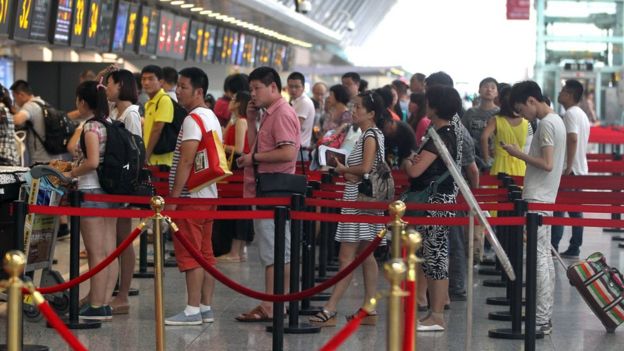
China has seen a huge growth in air passenger numbers
But how exactly are a growing number of Chinese airlines able to offer bargain prices that undercut more established rivals from Europe, the US, Asia, and the Middle East? Are they playing fair?
And how are the Chinese carriers able to secure an increasing amount of often hard-to-get landing slots around the world?
China's main airlines are undoubtedly being subsidised by the Chinese government, says Shukor Yusof, founder of Endau Analytics, a Singapore-based aviation industry research group.
These subsidies enable the carriers, such as the big three - Air China, China Eastern and China Southern - to aggressively gain market share around the world without worrying too much about any losses along the way.
"Chinese carriers do not reveal details, or specifics," says Mr Yusof. "However, taking account of the numbers that are flying, it would be fair to say that some are breaking even, many lose money, and few are able to eke out profits."
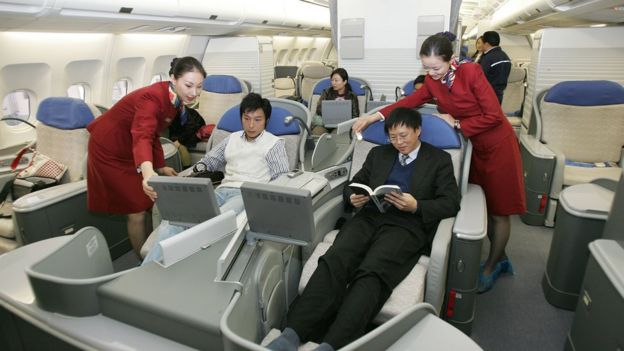
Analysts say the big Chinese airlines have worked hard to match the cabin qualities of the established carriers of the West
China's airlines are also benefiting from regional Chinese governments offering them subsidies to run international flights from their main cities, in the hope of putting them more on the map, and encouraging tourism and economic development.
In 2016 regional Chinese authorities outside Beijing, Shanghai and Guangzhou spent at least 8.6bn yuan ($1.3bn; £1bn) subsidising airlines, mostly towards international flights, according to data compiled by research group Civil Aviation Data Analysis.
One of the smaller Chinese carriers, Sichuan Airlines, offers services to Los Angeles from Hangzhou and Jinan, and both flights are said to rely heavily on subsidies, with less than 60% of seats full, compared with the global, industry-wide average of 81.4% in 2017.
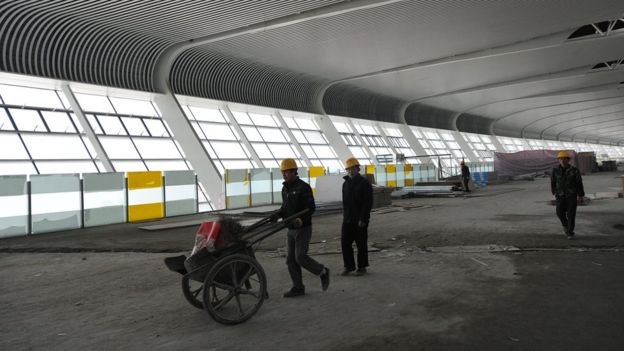
China has built 55 new airports since 2010
Thanks to the financial support from the Chinese government - which is the majority owner of Air China, China Eastern and China Southern - the Chinese carriers also have the funds to buy landing slots around the world. These can cost tens of millions of dollars, with airlines having to buy them from other carriers.
Yet while the Chinese government is undoubtedly using its financial muscle to help Chinese airlines grab a growing share of the global aviation market, it would be far too simplistic to attribute the rising dominance of the country's carriers to state sponsorship alone.
Instead you have to remember that China is the world's most populous country, and a growing number of its people can afford to fly overseas on holiday. This comes at the same time as countries in the West have eased visa restrictions on Chinese travellers.
Mr Yusof says that the number of people from mainland China flying abroad has more than doubled over the past decade, "the fastest [rate] in the world".
"We are talking close to 100 million seats in 2017 alone," he says.
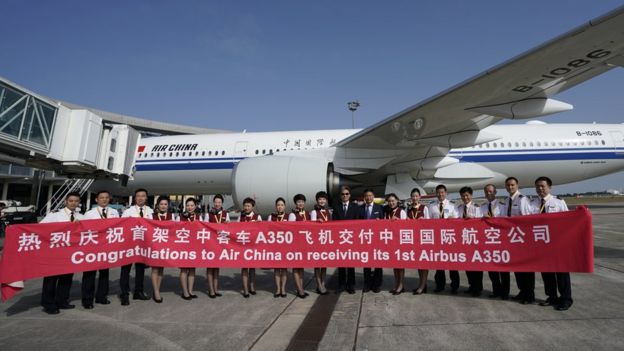
The main Chinese airlines have invested millions in new planes
Outside of Asia, the most popular overseas destination for Chinese holidaymakers is the US. These Chinese tourists spend on average almost $7,000 (£5,500) per trip, according to the US Travel Association.
Given the boost this gives to the tourism industry in the US and Europe, you can see why governments are quite happy to see more flights from China.
In fact, the growth in international Chinese passenger numbers is so extensive that China is forecast to overtake the US as the world's largest aviation market by 2022, according to the International Air Transport Association industry body.
More from the BBC's series taking an international perspective on trade:
To meet this big rise, China is also continuing to build many more airports. In 2010 the country had 175 airports. It now has 230.
Andrew Herdman, director general of the Association of Asia Pacific Airlines, says that another factor behind the increased international passenger numbers of Chinese airlines, is the rise in quality of the service they offer passengers.
"Chinese airlines have made successful efforts to narrow the gap in perceived service levels through investments in products and customer service, and close alignment with international benchmarks," he says.
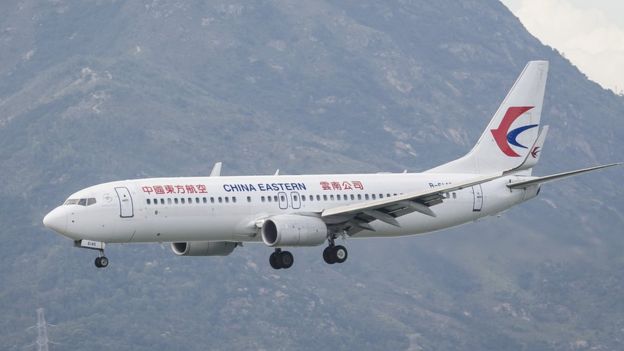
The Chinese government is the biggest shareholder in the country's largest three airlines - China Eastern, China Southern, and Air China
As a result of this increase in quality, a growing number of Western - and Chinese - travellers are happy to fly with Chinese carriers, especially if they can save money in the process.
But back to the financial support that the Chinese central government, and the country's regional authorities, give the country's airlines. Peter Harbison, executive chairman of Sydney-based research group Centre for Aviation, says it would be hypocritical of the US and European countries to complain too much.
"The entire [international] aviation regulatory structure is built around unfairness, with enormous protectionist barriers to entry," he says. "It is embarrassing for anyone to assert unfair competition in aviation."
Mr Yusof agrees: "It's a bit rich, in our view, for Western airlines to criticise the three major Chinese carriers for the aid they receive... when US and EU carriers also get large doses of subsidies from their respective authorities."